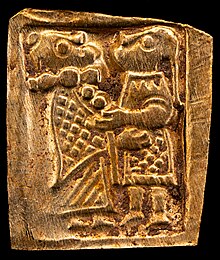 Global Information
Global InformationGullgubber information



Gullgubber (Norwegian, pronounced [ˈɡʉ̀lːˌɡʉbːər]) or guldgubber (Danish, pronounced [ˈkulˌkupɐ]), guldgubbar (Swedish, pronounced [ˈɡɵ̂lːdˌɡɵbːar]), are art-objects, amulets, or offerings found in Scandinavia and dating to the Nordic Iron Age. They consist of thin pieces of beaten gold (occasionally silver), usually between 1 and 2 cm2 (0.16 and 0.31 sq in). in size, usually stamped with a motif, and are the oldest examples of toreutics in Northern Europe.
The word gullgubbe means "little old man of gold" and is taken from a report published in 1791 by Nils Henrik Sjöborg,[1] in which he said that villagers in Ravlunda, Scania, who found them in the dunes called them guldgubbar.[2]
Approximately 3,000 gullgubber have been found, from approximately 30 sites in Norway, Sweden, and the greatest number in Denmark. No fewer than 2,350 were found at the settlement of Sorte Muld on the Danish island of Bornholm, while over 100 were found at Lundeborg, near Gudme on the Danish island of Funen, and 122 at Uppåkra, Scania, Sweden.[3] Relatively few gullgubber have so far been found in Norway, although 19 were found during excavations at Vingrom church in Oppland between 2003 and 2005, and the distribution of finds may be affected by modern circumstances as much as the political situation at the time they were laid down.[4]
They date to the late Iron Age, from the end of the Migration Age to the early Viking Age, particularly what is referred to in Norway as the Merovingian era, in Sweden as the Vendel era, from 550 to about 800, but can be hard to date because they are often found in contexts that do not establish date. It seems likely that they replaced bracteates, which require far more metal, after obtaining gold from the Byzantine Empire became difficult.[5]
- ^ Margrethe Watt, "The Gold-Figure Foils (Guldgubbar) from Uppåkra," Archived 2016-03-04 at the Wayback Machine in Lars Larsson, ed. Continuity for Centuries: A ceremonial building and its context at Uppåkra, southern Sweden. Stockholm: Almqvist & Wiksell, 2004, ISBN 91-22-02107-8, pp. 167-221, p. 167.
- ^ Topographia paroeciæ Raflunda et monumentorum quæ circa sunt: quam publico examini offerunt praeses Nicolaus H. Sjöborg et respondens Gustavus Sjöborg (dissertation, University of Lund, 1791, Latin), OCLC 248443661; later account in Swedish in Nils Henrik Sjöborg, Försök till en nomenklatur för nordiska fornlemningar, Stockholm: Delén, 1815, p. 112.
- ^ Watt, pp. 168 (map), 169 (Uppåkra).
- ^ Martin Rundkvist, "Östergötland's First Gold Foil Figure Die Found at Sättuna in Kaga Parish," Archived 2021-06-12 at the Wayback Machine Fornvännen 102 (2007) 119-22, p. 120 makes this point with respect to the dies used to make gullgubber: unlike the foils themselves, they register on metal detectors, and the fact that they have so far been found concentrated in southern Scandinavia likely reflects the relative prevalence of metal detectorists.
- ^ Rundqvist, p. 119.